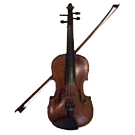

 |
This is an informal description of the MusiCAD file syntax.
Every tune starts literally with: melodie "<tune name>";
Comments
Everything left from an exclamation mark will be ignored (unless the second character is % or #).
Layout
Lines starting with: !# contain layout/setup information in the form:
<NAME1>=<VALUE1>;<NAME2>=<VALUE2>;
each item terminated with a semicolon
Objects
Notes (and other objects) are terminated with a semicolon.
Duration
notate as: 1/8; 3/16; etc or 0 for duration=0
denominators can be 1, 2, 3, 4, 6, 8, 12, 16, 24, 32, 64, 128
Pitch
Every note has a non-zero pitch Rests are notated as R.
A#3 Note A-sharp in 3rd octave
+## shift note to the right
+##+## second parameter is stem length adjustment
R Rest.
R+## shift rest to the right
R+##+## second parameter is is vertical shift.
Enhancements
|
. |
staccato (at rest means"multi rest") |
|
m |
mordent |
|
~ |
prall |
|
c |
long prall (MusiCAD2: 0xF7) |
|
r |
trill |
|
z |
Schleifer |
|
^ |
fermate |
|
p |
non-legato |
|
s |
staccatissimo (also expansion-rest due to "multi rest" in a score) |
|
e |
roll (MusiCAD2: ê = 0xEA) |
|
e1 |
single roll |
|
e2 |
double roll |
|
e3 |
triple roll |
|
e* |
cymbal crash (drums) |
|
eO |
hi-hat open (drums) |
|
O |
other (instrument specific signs) |
|
boo | |
|
on | |
|
ok |
dynamic accent < |
|
bog |
dynamic accent > |
|
Loa |
marcato |
|
Q |
tenuto |
|
ox |
mordent-schleifer |
|
v# |
fingering (# can be 0-9,a-Z) |
|
|
|
|
$ |
enharmonic exchange (duration<>0), hide item (duration=0) |
|
$$ |
alternate enharmonic exchange |
|
& |
following note |
|
{ | |
|
' |
split cluster-notes |
|
} |
clusterize |
|
u | |
|
d |
force stem down |
|
( |
start tie |
|
) |
end tie |
|
a |
courtesy accidental (MusiCAD2: 0xCE) |
|
? |
hide note |
|
|
|
|
i |
other note-forms (MusiCAD2: 0xA8) |
|
iQ |
flageolet open |
|
iZ |
flageolet closed |
|
is |
cue note (MusiCAD2: 0xF9) |
|
iD |
cross-shape (drums) |
|
i/ |
slash shape (guitar) |
|
f |
parenthesize (MusiCAD2: 0xAD) |
|
|
|
Further specification for duration non zero
Clef:
|
=v |
treble clef |
|
=b |
bass clef |
|
=n |
tenor clef |
|
=a |
alto clef |
|
=s |
drum clef |
|
=e |
none (no clef) |
|
=+ |
8va |
|
=- |
8va-basso |
|
=. |
loco |
|
=_ |
15ma-bassa |
|
=* |
15ma |
Key
|
=Bb |
B-flat |
|
=F#m |
F-sharp-minor |
Meter
|
=3/4 |
triple meter |
|
=2+3/8 |
compound meter 5/8 displayed 2+3/8 |
|
=2+3+2)/16 |
compound meter 7/16 displayed 7/16 |
|
=04/4 |
common meter: C |
|
=002/2 |
alla-breve, divided common meter |
Text
|
+ |
Lyrics 1 |
|
- |
Lyrics 2 |
|
T |
Lyrics 3 |
|
L |
Lyrics 4 |
|
` |
Directions 1 |
|
i |
Directions 2 |
|
P |
Directions 3 |
|
# |
Bar text |
|
, | |
|
_ | |
|
t |
Tempo change (MusiCAD2: ë 0xEB) |
|
M |
MIDI-event (MusiCAD2:û 0xFB) |
|
K |
color change |
|
Q |
Symbols (from MusiCAD-font) |
|
r |
cipher at multi rest (MusiCAD2: O 0xF7) |
|
DJ |
Section |
|
^ |
Text-files inclusion |
Every text may be shifted: 0-3+4 +"Tekstje"
-3 3 vertical units to the left
+4 4 horizontal units up
Text may be sized: 0 +<3>"Tekstje"
<3> 3 units larger than default for the text..
Special objects
|
@A |
Arpeggio |
|
@< |
Crescendo (obsolete) |
|
@> |
Decrescendo (obsolete) |
|
@P |
Pedal |
|
@X |
End-pedal |
|
@K |
Comma |
|
@O |
Coda |
|
@S |
Segno |
|
@B |
Paragraph-sign |
|
@C |
al Coda |
|
@D |
Da-capo |
|
@G |
Dal-Segno |
|
@c |
Da-capo al Fine |
|
@s |
Dal-Segno al Fine |
|
@F |
Fine |
|
@I |
Intro |
|
@Z |
Bar-repeat |
|
@z |
Phraze-repeat |
example:
0-3+2 @S;
Segno-sign 3 units left and two up
|
*1 |
prima volta |
|
*2 |
secunda volta |
|
%## |
whitespace (obsolete) |
|
/ |
new line |
|
// |
new page |
|
| |
(pipe-symbol) thick bar line |
|
l |
thin bar line |
|
I |
conditional line break/page break |
|
: |
repeat signs at bar line example: 0-1 l; bar line decreasing automatic bar numbering with one |
two-item objects
|
[<1 |
start crescendo number 1 (numbering is needed for overlap) |
|
]<1 |
end crescendo number 1 |
|
> |
decrescendo |
|
_ |
line (underscore) |
|
| |
fat line |
|
p |
dotted line |
|
( | |
|
) |
slur above |
|
[ |
hooked line below |
|
] |
hooked line above |
|
~ |
example
0+5-2 [>0 start decrescendo number 0, 5 units right and two down.


